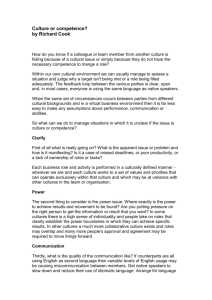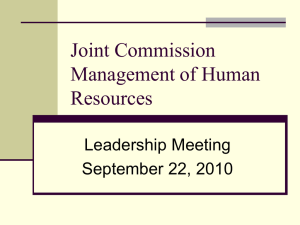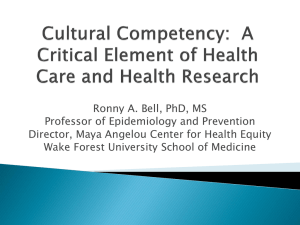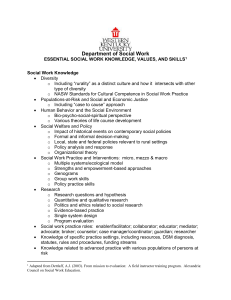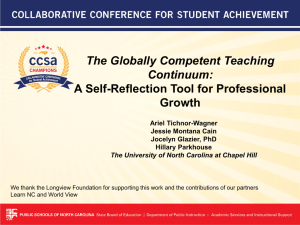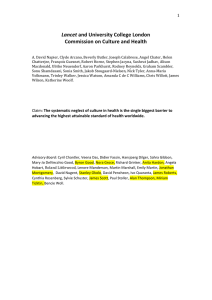Cross Model Cultural Competency Jason Mak
advertisement
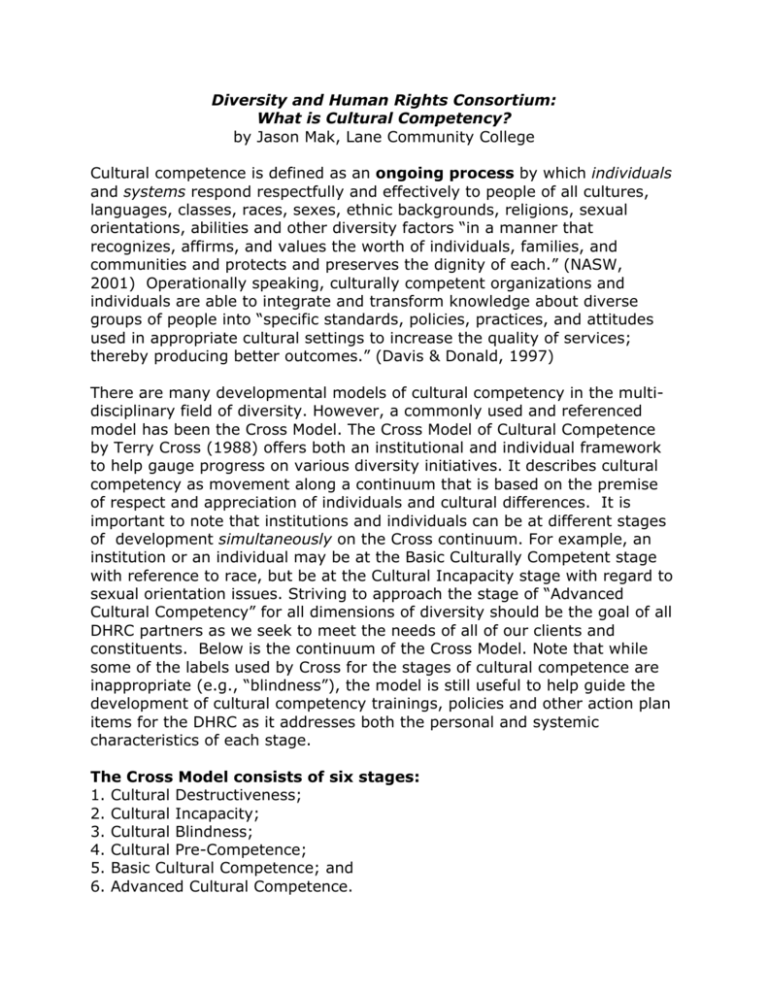
Diversity and Human Rights Consortium: What is Cultural Competency? by Jason Mak, Lane Community College Cultural competence is defined as an ongoing process by which individuals and systems respond respectfully and effectively to people of all cultures, languages, classes, races, sexes, ethnic backgrounds, religions, sexual orientations, abilities and other diversity factors “in a manner that recognizes, affirms, and values the worth of individuals, families, and communities and protects and preserves the dignity of each.” (NASW, 2001) Operationally speaking, culturally competent organizations and individuals are able to integrate and transform knowledge about diverse groups of people into “specific standards, policies, practices, and attitudes used in appropriate cultural settings to increase the quality of services; thereby producing better outcomes.” (Davis & Donald, 1997) There are many developmental models of cultural competency in the multidisciplinary field of diversity. However, a commonly used and referenced model has been the Cross Model. The Cross Model of Cultural Competence by Terry Cross (1988) offers both an institutional and individual framework to help gauge progress on various diversity initiatives. It describes cultural competency as movement along a continuum that is based on the premise of respect and appreciation of individuals and cultural differences. It is important to note that institutions and individuals can be at different stages of development simultaneously on the Cross continuum. For example, an institution or an individual may be at the Basic Culturally Competent stage with reference to race, but be at the Cultural Incapacity stage with regard to sexual orientation issues. Striving to approach the stage of “Advanced Cultural Competency” for all dimensions of diversity should be the goal of all DHRC partners as we seek to meet the needs of all of our clients and constituents. Below is the continuum of the Cross Model. Note that while some of the labels used by Cross for the stages of cultural competence are inappropriate (e.g., “blindness”), the model is still useful to help guide the development of cultural competency trainings, policies and other action plan items for the DHRC as it addresses both the personal and systemic characteristics of each stage. The Cross Model consists of six stages: 1. Cultural Destructiveness; 2. Cultural Incapacity; 3. Cultural Blindness; 4. Cultural Pre-Competence; 5. Basic Cultural Competence; and 6. Advanced Cultural Competence. 1. Cultural Destructiveness This is the most negative end of the continuum. Individuals in this phase: Diversity and Human Rights Consortium: What is Cultural Competency? a) view culture as a problem; b) believe that if culture or population can be suppressed or destroyed, people will be better off; c) believe that people should be more like the “mainstream”; and d) assume that one culture is superior and should eradicate “lesser” cultures. At the organizational level, this viewpoint taken to the extreme leads to such things as genocide and the boarding schools mandated in the late nineteenth and early twentieth centuries by the Bureau of Indian Affairs. These schools attempted to destroy the cultures of many Native American tribes. 2. Cultural Incapacity Individuals in this phase: a) lack cultural awareness and skills; b) may have been brought up in a homogeneous society, been taught to behave in certain ways, and never questioned what they were taught; c) believe in the racial superiority of a dominant group and assume a paternalistic posture toward others; and d) maintain stereotypes. At the organizational level this translates into supporting segregation or having lower expectations of persons from other cultures. 3. Cultural Blindness Individuals in this phase: a) see others in terms of their own culture and claim that all people are exactly alike; b) believe that culture makes no difference (“we are all the same”); and c) believe that all people should be treated in the same way regardless of race, etc. At the organizational level, services are so ethnocentric that they are virtually useless to all but the most assimilated. 4. Cultural Pre-Competence Individuals in this phase: a) recognize that there are cultural differences and start to educate themselves and others concerning these differences; b) realize their shortcomings in interacting within a diverse environment; but c) may become complacent in their efforts. At the organizational level, this phase leads institutions to attempt to address diversity issues by, for instance, hiring a diverse staff, offering cultural sensitivity training, promoting diverse staff to upper management, and so on. 5. Basic Cultural Competence Individuals in this phase: a) accept, appreciate, and accommodate cultural differences; b) value diversity and accept and respect differences; c) accept the influence of their own culture in relation to other cultures; d) understand and manage the dynamics of difference when cultures intersect; and e) are willing to examine components of cross-cultural interactions (communication, problem solving, etc.). At the organizational level, this phase leads to an effort to hire unbiased employees, to seek advice from communities of color (and others), and to assess what can be provided to diverse clients. 6. Advanced Cultural Competence Individuals at this phase: a) move beyond accepting, appreciating, and accommodating cultural difference and begin actively to educate less informed individuals about cultural differences; b) seek out knowledge about diverse cultures, develop skills to interact in diverse environments, and become allies with and feel comfortable interacting with others in multicultural settings. At the organizational level, this translates into conducting research on diversity, hiring staff who are specialists in cultural competence practices, and acting as an advocate for historically underrepresented groups and for multiculturalism. In surveying different models of cultural competency, listed below are the basic set of common skills that individuals need to interact in a culturally competent manner (Anand, 2000): 1. Being aware of one’s own culture, values, and biases. 2. Being aware of and working at controlling own biases and how these may affect interactions with others. 3. Culture-specific knowledge. 4. Knowledge of institutional barriers that prevent some populations from accessing resources. 5. Ability to build strong cross-cultural relationships and to be at ease with difference. 6. Flexibility and ability to adapt to diverse environments. 7. Ability and willingness to be an ally to individuals who are different from oneself. 8. Effective communication skills across differences. 9. Able to mediate cross-cultural conflicts. Remember that cultural competency is much less an outcome than it is a process that seeks to continually improve and adapt interactions, relationships, services, coalitions, and planning for a more equitable, caring and inclusive future. References Anand, Rohini. (2000). Teaching Skills and Cultural Competency: A Guide for Trainers. Fourth Edition. Washington, DC: National Multicultural Institute (NMCI) Publications. Cross, Terry. (1988). Services to minority populations. Cultural competence continuum. Focal Point, 3, pp. 1–9. Davis, P., & Donald, B. (1997). Multicultural counseling competencies: Assessment, evaluation,education and training, and supervision. Thousand Oaks, CA: Sage Publications. NASW National Committee on Racial and Ethnic Diversity. (2001) NASW Standards for Cultural Competence in Social Work Practice. http://www.naswdc.org/pubs/standards/cultural.htm WMU Project AGE. Developing Cultural Competence. in Western Michigan University Project AGE’s website at http://www.wmich.edu/hhs/ProjectAGE/focus_toc.html

